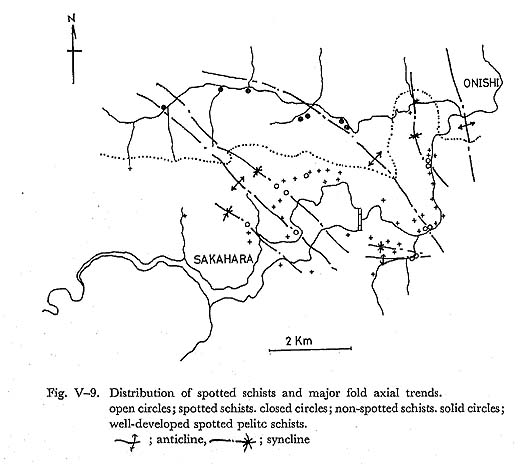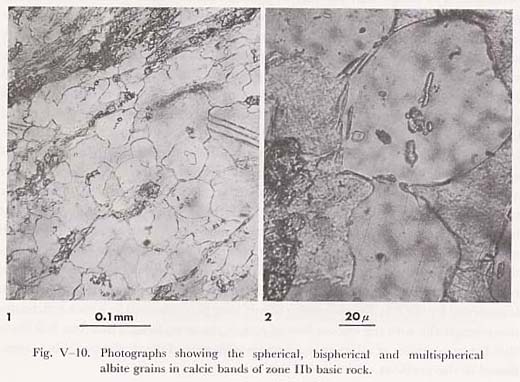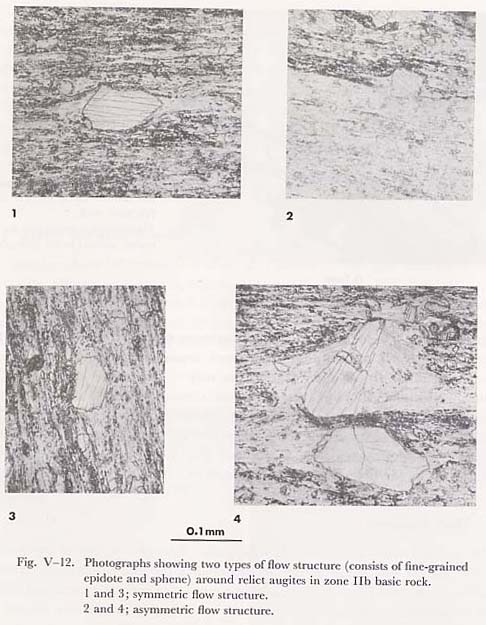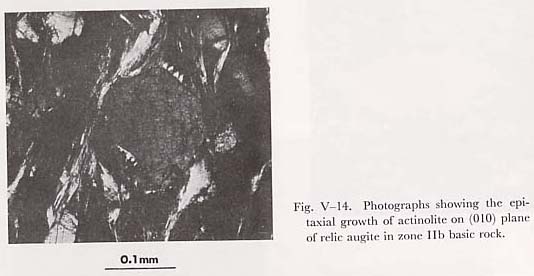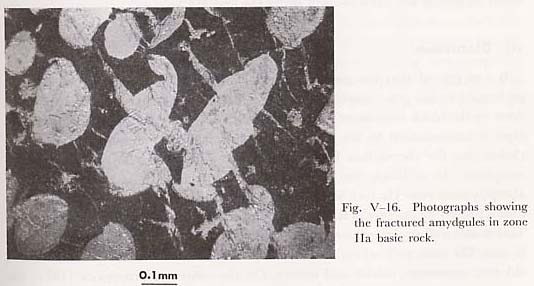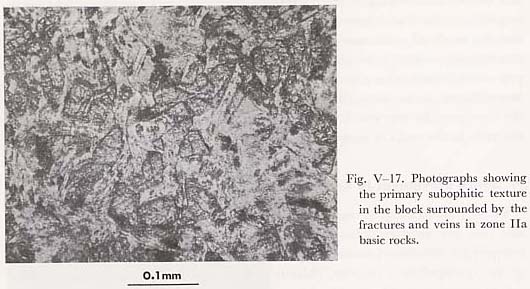V. INTERNAL TEXTURE OF ROCKS
i) IntroductionAs discussed in the previous chapter, rocks of the Sambagawa group are strongly schistose and intensely folded, while in the Chichibu group they are weakly schistoose and show undulated folding. The folds in the Sambagawa group are the flow type fold, whereas in the Chichibu group they are the lends fold. Therefore, the lens fold zone comprises the metamorphic zones I and IIa, and the flow fold type one does the zones IIb and III. ISHIKAWA (1971) has also clarified the clear difference of the fold type between the prehnite-pumpellyite and actinolite-epidote zones in the Tenryu district of the Sambagawa metamorphic terrane. He has concluded that this difference of folding type is due to the deformation tempera ture, though the author considered that it is resulted from the difference of deformation mechanism constrained by temperature, being coupled with recrystallization. Then, the temperature and pressure conditions govern the metamorphic mineral assemblages, through which they control the rock-deformation. The lens fold is formed by the conjugated micro fault system, while the flow fold by the viscous flow of rock (TURNER and WEISS, 1963). Such movement of rock enlarges the total surface of metamorphic minerals and in such a way it advances the metamorphic reaction. Therefore, the deformation styles also control the order of recrystallization during metamorphism. It seems that if the recrystallization advances the viscous flow, and if the viscous flow also proceeds the recrystallization, the system consisting of rock-deformation and recrystallization is the self-accelerated. In this case, the displacement velocities of rocks may become large with time. The internal textures of rocks, i.e., schistosity, flow structure, local heterogeneity of mineral composition and others are formed by such deformation accompanied by recrystallization. Therefore, in this chapter the author discusses the elementary deformationmechanisms of lens- and flow-foldings. ii) Porphyroblastic AlbitePorphyroblasitc albite occurs commonly in low-grade regional metamorphic terranes. It is widespread also in the Sambagawa metamorphic rocks and has been called "Albite Spot" in Japanese papers. Albite spot occurs restricted in the higher grade zones in the Sambagawa metamorphic rocks. From these occurrences, albite spot has been considered to be the fully grown albite grain with rising temperature. However, even high grade metamorphic rocks in other metamorphic terranes do not always contain the porphyroblastic albite or plagioclase. It may be suggested that the albite spot is not caused only by rising temperature. a) General featureThe albite spot and related texture are illustrated in Fig. V-1. Various mineral assembalges occupy the domain surrounding the albite spot. Three domains can be recongnized by the mineral associations; epidote + sphene association (A) is in. albite spot, chlorite + quartz (C) is surrounding the albite spot, actinolite + chlorite (D) surrounding the (C), and epidote+sphene+actinolite+chlorite(E) occupies the matrix. Along the rim of albite spot, actinolite + quartz + epidote + sphene (B) is not rare.
The albite spot in basic rocks of zone III is almost always attended by these mineral associations, while in the zone IIb, albite spot is not followed by the domain of (C). Epidote and sphene in albite spot are spheroidal fine grains (1 to 5 microns) and occur as stringed aggregate (so-called "helcitic texture"). The do mains (C) and (D) constitute the pressure shadow of albite spot. Albite spots in politic rocks contain graphite, sphene, rutile, garnet and hematite as inclusions. They consist of the core part rich in these inclusions and clear rim free from inclusions. The boundary between core and rim of the albite spot is sometimes sharp. The variation of mineral association around the albite spot was not observed in the pelitic rocks, while in the chlorite-rich psammitic rocks the domain consisting of chlorite and muscovite surrounds the albite spot. Helcitic strings of graphite, sphene and hematite inclusions are common and clearly eliminated at the boundary between the core and rim. b) Chemistry of minerals related to albite spotAlbite spot shows no compositional zoning, and its composition is nearly pure albite in pelitic and basic rocks of zones IIb and III. Epidote and amphibole occur in the albite spot and in the domains surrounding the albite spot. Compositional variations of epidote in the albite and in the matrix (E) are shown in Fig. V-2. This figure indicates that the compositional range of inclusion epidote is covered by that of the matrix epidote, and the frequency patterns of Fe/(Al+Fe) ratio in them are similar to each other. A difference of compositional range between matrix and inclusion epidotes is smaller than that between zone IIb and zone III epidotes. Therefore, the compositional variation of inclusion epidote is nearly equal to that of matrix epidote. It is noteworthy that the complex-zoned epidote, which is composed of the iron-poor core and iron-rich mantle, occurs only in the matrix(E).
Furthermore, the compositional range of epidote in the core part of albite spot is also similar to that in the rim of albite spot. Compositional zoning of epidote in the albite spot and in the matrix shows an increase of Al toward the rim. As discussed in the chapter of mineralogy, epidote becomes aluminous with increasing metamorphic temperature, and its zoning is formed by rising temperature (progressive zoning). Therefore, above mentioned compositional similarity between matrix and inclusion epidote indicates that these epidotes have recorded the same chemical process during progressive metamorphism. Amphiboles in the matrix and in the albite spots have such a compositional similarity as epidote does. On the other hand, chlorite occurs as compositionally homogeneous grain in the domains D and E. The chemical composition of chlorite in the matrix is similar to that in the actinolite+chlorite association (D). In summary, the variation of mineral assemblages around and in the albite spot is not accompanied by the compositional differences of epidote, chlorite, actinolite and albite. Further, there is no difference in the chemical process of epidote formation in or out of the albite spot. Thus, the process, which induced albite spots and heterogeneous distribution of metamorphic minerals around them, is not accompanied by the metamorphic reaction. Therefore, the inclusion strings must be the boundaries of some albite grains and hence the albite spots must be also the polycrystalline aggregates of albite grains. In other words, spotted albite and related textures were formed by the mechanical process, i.e., mechanical accretion of many albite grains which had been produced by the metamorphic chemical reaction. c) The variation of modes of sphene and epidote in the interstice between albite spotsThe albite spots are randomly distributed in the basic and pelitic metamorphic rock specimens, though some specimens contain bands consisting with spot-rich and-poor layers. Hence, the frequency of the distance between two albite spots has the gaussian distribution. Microscopical observation indicates the heterogeneous distribution of metamorphic minerals in the matrix parts. Such heterogeneity was described in detail in the previous chapter, and it is considered to be induced by the mechanical accretion of albite grains, on the basis of chemical homogeneity of metamorphic minerals. Mechanical accretion model for albite spot genesis leads us for gaussian distribution of distance between nearest neighbourhood albite spots to be due to the random movement of albite grain and aggregated albite spots. Hence, heterogeneous distribution of metamorphic minerals in the matrix may be induced by the random movement of accreted albite spots in the latest stage of accretion of albite grains in metamorphism. The modal proportion of sphene and epidote in the interstices between nearest neighbourhood albite spots was measured by the point-count method. Fig. V-3 indicates the clear relationship between the distance and the modal proportion of epidote and sphene. It makes to conclude that sphene and epidote segregate in the narrow space between closing two albite spots, and then actinolite and chlorite are transported from that space. The process of this mechanical separation can be analogous to the shape segregation experimented by RIPPIE et al (1967). From RIPPIE'S interpretation on the shape segregation, the segregation mechanism is the competition for the space induced by the rough compaction between distinctively shaped grains. It follows that rounded epidote and sphene remain in the interstice, while elongated actinolite and thin-platy chlorite are transported from the interstices. Therefore, the area surrounding two closing albite spots could be occupied by the transported actinolite and chlorite. This mechanical seperation model for the variation of mineral composition in various interstices may explain the existence of actinolite+chlorite association(D) surrounding the two albite spots(Fig. V-6),and the compositional similarity of chlorite, actinolite and epidote in various interstices and other domains surrounding albite spots.
Above mentioned shape segregation can easily explain the constraint mineral species of inclusions in albite spots and the domains surrounding albite spots.Epidote and sphene in the albite spots are the segregated minerals in the grain boundaries of accreted albite grains, and then the strings of them are the remnant grain boundaries of the early stage aggregated albitcs. Furthermore, it is concluded that the domains surrounding albite spots are the aggregates of transported chlorite and actinolite from the space being occupied by the accreted albite grains. These processes occurred before the metamorphic chemical reaction producing actinolite, chlorite, epidote and others, so that the chemical compositions of these minerals in the albite spots are similar to those in the domains. Crystallographical homogeneity of accreted albite grain can be interpreted by the anneal process as discussed in the following chapter. d) Grain size distributionTo measure the grain size of albite in basic schists of zone III, the rock samples were cut along the plane normal to the tectonic axis a. The ratio of inscribed circle radius against circumscribed circle of albite spot on the (b-c) plane has measured by NOMI (1969), who obtained this ratio to be around 0.8. The author, therefore, measured the radius of the inscribed circles of albite spot on (b-c) plane. Grain size distribution is shown in Fig. V-7. Numbers of measured grains are more than 400 in each rock sample. These figures show that the r/r* ratio ranges from 0.0 to 10, ifr* is 40 microns, and ifr* is 10 micron, this ratio does from 0.0 to 4.0. Further, the frequency distribution of grain size shows the bimodal pattern in the latter case, and in the former, it is multi-modal.
On the other hand, the size distribution of euhedral garnet in zone III pelitic rock shows the unimodal pattern (Fig. V-8) and the ratio of r/r* (r*=10 micron) ranges from 0.0 to 2.4. A difference of grain size distributions between garnet and albite may not be explained by the difference of crystallographical symmetry between garnet (cubic) and albite (triclinic). It has to be explained by the difference of growth mechanism between them in the metamorphism.
As discussed in the section of mineralogy, garnet in zone III pelitic rocks shows the compositional zonal structure formed by rising temperature. Thus euhedral garnet is not the combined garnet. In other words, garnet grains in pelitic rocks are formed from some of garnet nuclei in the early stage of metamorphism, through the preferential growth process of nuclei. Theoretical grain size distribution has been answered by HILLERT (1965) in the preferential growth from many nuclei. HILLERT assumed that the velocity of grain boundary is expressed by following equation; dR/dt = Msg(1/r1 + 1/r2), where M, r1 and r2 are mobility of grain boundary, and curvatures of boundary surface, respectively, and obtained the following size-distribution equation in the steady state; P(u) = Bu/(2-u)2+B(2e)Bexp[-2B/(2-u)], He also has answered the grain size distribution on the cross section as shown in Fig. V-8. According to his results, the ratio of r/r* ranges from 0.0 to 1.6, and the frequency of grain size is unimodal as shown in Fig. V-8. This frequency pattern is very similar to the observed garnet size distribution. Therefore, grain growth of garnet can be approximated by the HILLERT'S model, i.e., it is controled by the surface energy of garnet grain. On the other hand, albite grain growth cannot be explained by the HILLERT'S model, taking into account the fact that the ratio of r/r* reaches up to 10, and the frequency of grain size is multi-modal. The multi-modal frequency pattern and high r/r* ratio must be explained by the mechanical accretion model. These two facts can be explained easily by the model that albite spots are the aggregates of albite grains which grew preferentialy from many albite nuclei before the mechanical accretion. In this case the albite grains with r* radius (maximum frequency) have the highest probability of collision and thus the maximum frequency of combined albite grain is satisfied at the size of e) Spatial distributionAlbite spot has been named porphyroblastic albite, and thus it may have been defined in terms of the grain size. The grain size distribution, however, indicates that the grain size of albite falls in one rock in a wide range. It is not statistically acceptable that the albite spot is defined by the maximum grain size in a rock. The albite spotted schist must be defined in terms of the grain size with maximum frequency. Thus, to obtain the spatial distribution of spotted schist the grain size distribution must be obtained. However, it is proved that the albite spot is accompanied by the characteristic textures around and in the large albite. Local concentration of epidote and sphene in the albite spot characterizes the spotted schist. The distribution of spotted schist defined by above mentioned way is shown in Fig. V-9. The albite spotted schists occur even in the "non spotted schist province", reported by SEKI (1958), and they do in a whole area of zone III. It is emphasized that the spotted schists in zone IIb occur restrictedly at the vicinity of the axial parts of major folds. Further, the spotted pelitic schist containing large albite spot occurs at the major fold axial parts in zone III. The rock at the axial parts of the major folds is largely strained by the compression. On the other hand, it is proved that the albite spot and related textures have been formed by the mechanical accretion of many albite grains and by annealing of collided albite grains. The collision of albite grains requires for the shortening the average distance between albite grains. In other words, the collision is caused by the uniaxial shortening of rocks. This mechanical accretion model, therefore, can explain the restricted occurrence of spotted schists in zone IIb basic rocks.
f) DiscussionThe genesis of albite spot has been explained by the mechanical accretion model of many albite grains which grew preferentially from the albite nuclei during metamorphism. The formation of crystallographically homogeneous grain from the combined albite grains may be explained by annealing process, i.e., the grain boundary-shift through the reconstruction of crystal cell. In the metallurgical experiments, it is shown that the rate of grain boundary shift is accelerated by the stress, and rising temperature, and deccelerated by the impurity. The anneal process can be formulated by the grain growth mechanism in terms of surface energy and internal energy of polycrystalline aggregate. The most effective intensive variable to the anneal process is the temperature, but as the grain boundary shift can be expressed as dislocation climbing in crystal, the anneal controlled by the grain boundary shift is accelerated by the stress. The dislocation climbing is induced by the vacancy movement, being biased by the stress, while it is disturbed by the impurity in such a way that microscopic strain field around the dislocation interacts with that around the impurity. Thus albite, having the composition of pure albite, may be annealed easier than zoned actinolite, epidote and other mafic minerals under the stress field. Therefore, chlorite, actinolite and epidote may not have grown in such a way as albite spot has done, even if their grains collided with each other. In other words, chlorites, actinolites and epidotrs may behave as particles in the powder mass under the stress field. Then, albite grains may have the relative velocities against these minerals. Thus it is concluded that rock deformation is governed by the relative movement ofmetamorphic minerals in a rock constitutes macroscopically with the viscous flow of rock in the stress field. Therefore, it is likely that the appearance of albite spot coincides with that of the flow type folds as mentioned in the previous section. From these consideration, the grain growth induced by the mechanical accretion is governed by the rate of grain accretion and the rate of annealing. Grain accretion may be the random process, and the frequency distribution of its rate in a polycrystalline aggregate has the Gaussian distribution. On the other hand, the rate of annealing, as mentioned above, is controled by the concentration variation of impurity in mineral. Therefore, the grain growth induced by the mechanical accretion may be applied for calcite and quartz. Porphyroblastic calcite and quartz were not found in this area, but the composition band, consisting of albite, calcite and quartz were common in zones IIb and III basic rocks. The genesis of composition bands in basic schists will be discussed in the following chapter. iii) Albite in Calcic BandsGranular grains (40 microns) of albite are common in the calcic bands consisting of calcite, albite and quartz in schistose basic rocks of zone IIb. Calcite in these bands is interstitial to albite and quartz. Most albite garins are spheroidal, while some of them show the bispherical shape and include the strings of calcite patches along their neck parts (Fig. V-10). This bispherical shaped grain is the combined albite grains and included calcite strings represent the relict grain boundary between the primary two albites. It becomes crystallographically homogeneous through the anneal of combined grains, in such a way as the albite spot. The multi-spherical shaped grains are common and some of them have the twin boundary. This twin boundary does not coincide with the strings of calcite patches, that is, relict boundary. Therefore, the twin boundary is formed by the grain boundary shift. The albite twin is occasionally bended (Fig. V-11), suggesting the collision of grains under the stress field. The rotation of twin boundary was also observed.
iv) Flow TexturesIn the basic rocks of zone IIb, the flow texture defined by strings of fine grained epidote, sphene and relic augite occurs surrounding the relic augite grain. Pressure shadow on the both sides of relic augite is composed of chlorite, quartz and calcite with subordinate epidote, actinolite and sphene. The pressure shadow around the rounded augites of various size has geometrical similarity. The flow texture can be divided into two types; symmetric and asymmetric (Fig. V-12). The symmetric flow texture with pressure shadow around relic augite is more common than the asymmetric one. The strings of the symmetric flow are controled by the shape of the relic augite: if host augite has the concave surface against the matrix, the curvature of the strings is also concave against the matrix, and if it has convex surface, the curvature is convex.
On the other hand, the three basaltic rocks containing abundant relic augite were collected from a layer of basaltic lava at three localities. Their basaltic lavas contain many ellipsoidal patches which are composed of albite, calcite, quartz and actinolite with subordinate relic augites (Fig. V-13). The specimens containing depressed ellipsoidal patches have the above mentioned flow texture surrounding rounded augite (Fig. V-13). Thus flow texture may be drew up by the process of rock-deformation. It seems that the strings of fine grained metamorphic minerals and relic augites represent the laminar flow-line caused by the rock compression.The genesis of asymmetric flow line may be interpreted such a way that relic augite is squeezed into the matrix, and fine grained minerals escaped from the matrix near the augite. The epitaxial grain of actinolite around relic augite (Fig. V-14) being bended parallel to the flow line, has formed by the compression upon the relic augite.
The flow texture is common in the pelitic and basic rocks of zones IIb and III, and its core is relic augite, albite spot and relic hornblende, and the boudine of quartz+albite layer, and pumpellyite+chlorite aggregate. The flow textures around these minerals and aggregates have the geometric similarity with each other. Therefore, these texture may be drew up by the process of rock compression. On the other hand, relic augites have many parting, cracks, voids and deformation bands, and in these deformation breaks in relic augite, actinolite, sodic pyroxene, chlorite, albite and epidote are filled. These deformation breaks are caused by the same stress as the flow texture. Further, the epitaxial actinolite around relic augite and the metamorphic minerals filling these deformation breaks are also bended and have the deformation bands (Fig. V-15). It follows that such deformation of rock and mineral occured during metamorphism. In summary, the microscopical process of rock deformation in zones IIb and III is the grain displacement, and the mode of grain movement is controlled by its size, shape, compositional homogeneity, other intrinsic nature and intensive variables. This elementary process of deformation may lead us to conclude that the rock-deformation can be dealt with as the viscous flow. From this reason, the elastic strain of rock under the stress may be very small. Accordingly, the so-called tectonic overpressure does not arise in the rocks of zones IIb and III.
Veins, fractures and amygdules are common in basic rocks of zones I and IIa, and they are filled by following metamorphic mineral assemblages; prehnite + pumpellyite + chlorite + calcite + albite + quartz, pumpellyite + chlorite + albite + quartz, pumpellyite + chlorite, chlorite + albite+quartz, albite + quartz + calcite, calcite assembalges. The fractured amygdules are also filled with these assemblages (Fig. V-16). Veins and fractures arc extended with various length and they often cross with each other. The blocks surrounding these breaks contain a good deal amounts of relic augite, and albite pseudomorphs after the laths of primary plagioclase, sometimes maintaining the subophitic texture (Fig. V-17). Although the fracture zone acertained by crushed augite is common in these blocks, the flow texture around the relic augite and other deformation texture are not observed. Accordingly, it seems that the displacement in a block did not occur, and that the rock deformation was performed by the displacement of blocks along the fracture zone and veins. In other words, the rock deformation was done through the process of plastic deformation in the stress field.
On the other hand, the basic tuff and lapilli tuff in which relic augite is not found, have the flow texture around the lithic fragments. This flow structure is defined by the strings of the fine grained hematite, sphene and other opaque minerals. This flow structure may be also explained by the compression of rocks in such a way as that in the basic rocks of zones IIb and III. vi) DiscussionIt was proved that the rock deformation in zones IIb and III (flow fold) is performed by the grain displacement, while that in zones I and IIa (lens fold) is done by the block movement in the stress field. The rock deformation of these two types is accompanied by the metamorphic chemical reaction, and thus it is concluded that the viscous flow becomes dominant with rising temperature of metamorphism. In addition, the modal amounts of metamorphic minerals increase abruptly from zone IIa rock to the zone IIb rock, thereby showing that the viscous flow is caused by the production of metamorphic minerals with rising temperature. This model well explains the existence of flow structure around the lithic fragment in zone IIa basic tuff, which is completely recrystallized and composed of albite, chlorite, muscovite, calcite and quartz. On the contrary, TOKUYAMA (1971) has pointed out that the actinolite+epidote+ chlorite + albite assemblage occurs in the well-deformed axial parts, while the prehnite+chlorite+epidote+albite+quartz in weakly deformed rocks of wing parts. This fact indicates that the rock deformation may advance the metamorphic reaction accompanied with fluid phase. Therefore, it is concluded that the interaction between the rock deformation and the metamorphic reaction arise in such a way as they accelerate with each other. The above mentioned microscopical movements of minerals explain the mechanism of forming compositional banding in the schists. The grains in the banded rocks collide with each other during metamorphism, and some of collided grains repulse or anneal. Following these movements of grains, some of metamorphic minerals are segregated and others have the random distribution in rock. If we assume the bimineralic rock, and that all of grains have the same probability of collision, the segregation of one mineral is controlled by the rate of annealing of collided grains. If we assume that the A-A collided grain is perfectly annealed and other combination (B-B, A-B) are not annealed in the bimineralic rock, the grain of A is segregated with proceeding time in rock, and thus the grain of B also is segregated. Accordingly, the rock consists of the two domains being composed of A and B, respectively. If the collision of grains is one-dimentional, the rock is made by the stacking of A- and B-plates, i.e., the composition bands. The banded basic schists are composed of the chlorite+actinolite+epidote and albite+quartz+calcite bands. Albite, calcite and quartz can be annealed easier than chlorite, acrinolite and epidote, and thus it is acceptable that albite, calcite and quartz are segregated by the stress, while others escape from the calcic band and form the mafic bands. The reaction zone is revealed along the boundary between calcic and mafic bands in the basic schist of zone IIb. Therefore the compositional banding may be resulted from the mechanical accretion of metamorphic minerals during metamorphism, and formation of these bands arise the chemical gradient in rock. Then, the reaction zone between such bands are formed during metamorphism, and the rock shows the gneissosity. Accordingly, metamorphism accompanied by the stress contains the metamorphic reaction with rising temperature, and the mechanical redistribution of minerals. |
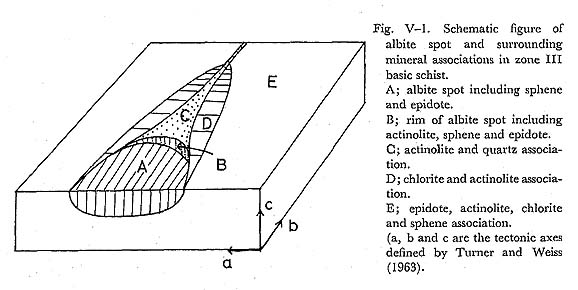
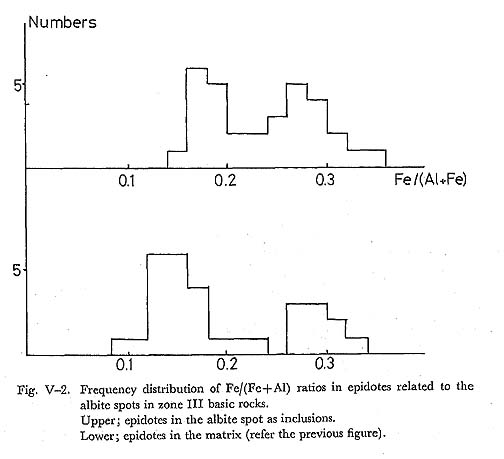
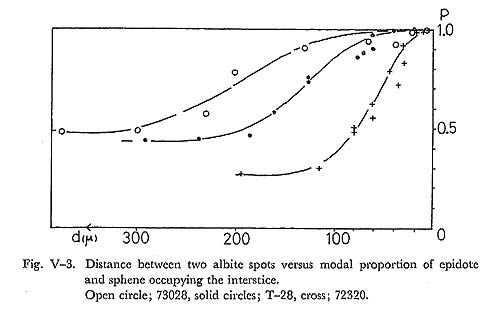


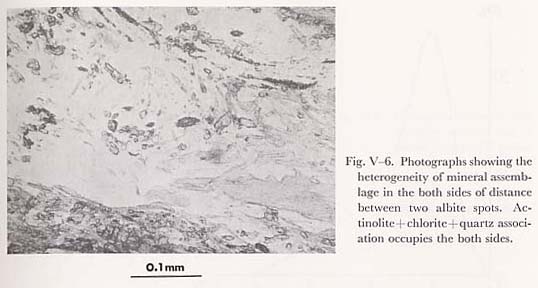

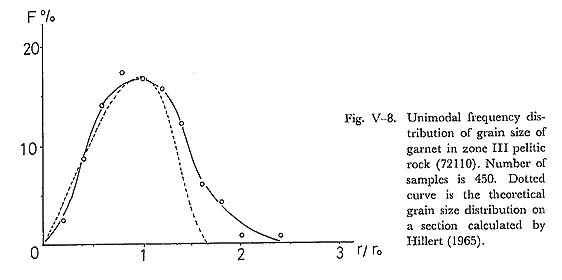
 . It follows that the size distribution pattern has the multi-modal shape as shown in Fig. V-7. The albite spot is crystallographically homogeneous, suggesting that the combined albite grain was annealed during and after the mechanical accretion. The anneal process will be discussed in the following sections.
. It follows that the size distribution pattern has the multi-modal shape as shown in Fig. V-7. The albite spot is crystallographically homogeneous, suggesting that the combined albite grain was annealed during and after the mechanical accretion. The anneal process will be discussed in the following sections.